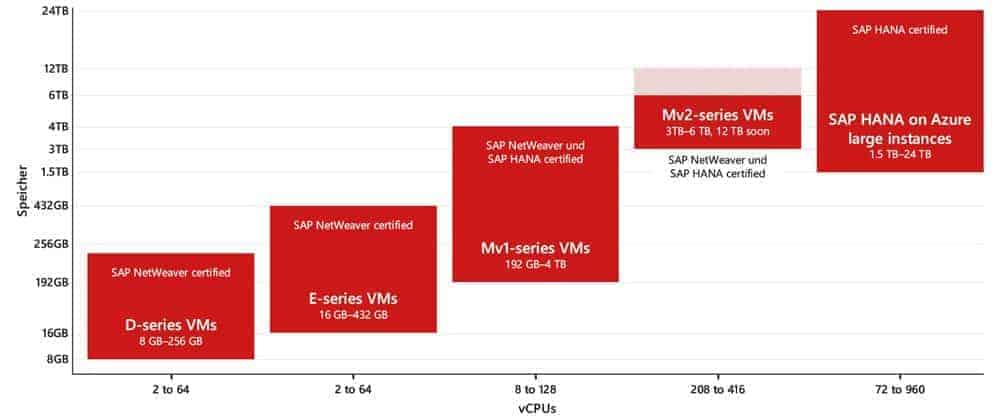SAP on Azure or SAP and Azure?


The cloud is more than large data centers with endless rows of server racks, CPUs and storage. These resources are the foundation.
But what really makes a good cloud is the range of services it offers. In Azure, the existing SAP customer will find more than 800 intelligent platform services (PaaS) and software offerings (SaaS).
Such PaaS services include, for example, machine learning models and an IoT platform that customers can use for their business processes.
A prominent representative of a SaaS solution is Office365 or, more recently, Azure Sentinel, a cloud-based and AI-supported SIEM (Security Information and Event Management) solution for the entire enterprise.
This is why Microsoft likes to use the term SAP and Azure. Migrating an SAP system to the cloud is much more than switching from local infrastructure to an IaaS offering.
SAP is at the center of projects for digital transformation with Robotic Process Automation (RPA), Internet of Things (IoT) or Artificial Intelligence etc.. Therefore, the actual added value increases significantly through integration with PaaS services.
From Microsoft's own experience, we know that the majority of all AI projects in Germany today use data from SAP.
Platform and services
Azure is Microsoft's cloud platform. Almost everything that Microsoft offers today in terms of cloud services is based on this platform.
The platform term is used to describe the global ecosystem of connected resources - the data centers, servers and networks - as well as the totality of services.
Azure maps all three levels of cloud computing: Infrastructure as a Service (IaaS), Platform as a Service (PaaS) and Software as a Service (SaaS).
The DSAG investment report from the beginning of this year showed that SAP legacy customers prefer the Microsoft cloud platform Azure.
However, the cloud is not a single product, but an offering with a wide range. Microsoft is always asked for the common thread and an overall story, especially when it comes to entry scenarios and a strategic approach for long-term success.
How can the analytical capability, security and reliability of Azure be used for SAP applications? How do you arrive at a resilient and realistic economic view and how do you approach a migration?
The cloud is a paradigm shift and must be structured and implemented at all levels - not only technically, but also in the daily way of working. The digital transformation is not just bits and bytes, but must also take place in people's minds.
In the coming E-3 issues, all relevant aspects of "SAP and Azure" will be covered, thus initiating the largest and most comprehensive knowledge transfer for this topic to date.
A typical customer starts with an assessment of the technical possibilities and options. Then the business case is developed and data protection is addressed before moving on to migration planning.
Hybrid and integration scenarios are considered and change management is initiated.
Data center and cloud
Many existing SAP customers use servers and applications in their own data center or at a service provider. According to Gartner, around ten percent of companies currently no longer have their own data center, and this figure is expected to rise to 80 percent by 2025.
The appeal is therefore not to wait and see, but to start the digital transformation today and help shape it so as not to lose touch.
Microsoft is the only relevant cloud provider whose products are also present in customers' data centers, which means that hybrid scenarios can be implemented at an early stage and support the customer's needs.
Microsoft Azure is the ideal platform as part of an integrative and consistent hybrid strategy: Various systems can be found in the same or similar form both on-premises, i.e., in-house, and on Azure in the cloud.
SAP integration must be consistent at all levels, from technology to business process. When operating SAP in the cloud, for example, it must be ensured that end users can log on as usual via a single sign-on - whether via the SAP GUI or the Fiori app.
With the provision of Azure NetApp Files (ANF), benefits familiar from the on-prem environment such as Hana ScaleOut, Snapshot and Cloning or Cloud Sync come into play (see also page 26).
Subsequently, integration takes place at the application level and also at the business process level. SAP workflows can thus be natively integrated into Outlook so that, for example, an approval can be issued directly from the mail.
There is no need to change the application. In addition, predictive models for revenue trends can be quickly and easily integrated into SAP using Azure Machine Learning, or comprehensive and interactive "no code" reporting can be built using Microsoft PowerBI. And this for all types of end devices, without having to write code yourself and directly from Hana.
In addition to the core question of whether a component is sourced from the company's own data center or from the cloud, there are also other aspects to evaluate: At the latest when latency times, certain data protection requirements or cost optimization are important, then the region should also be looked at.
It is true that cloud usage is location-independent and global, and platform services are offered identically in Germany, Europe or outside Europe under Azure, while the same compliance mechanisms are used everywhere. But nevertheless, on closer inspection, there are also differences.
Business Critical and Security
The logical structure of Azure in terms of location: A geography is a separate market, usually comprising one or two regions and preserving boundaries in terms of data residency and compliance. For example, Germany is a separate geography.
A region consists of multiple data centers deployed within a perimeter defined by latency requirements and connected via a dedicated regional network. Azure is currently available in 54 regions and 140 countries.
In addition to the geographical concepts, Azure has a number of other mechanisms to protect against failures. SAP systems are "business critical" and therefore need an above-average level of resilience.
DSGVO, BSI and BaFin
Anyone who entrusts their sensitive data to a cloud provider and wants to operate their systems there must be sure that the General Data Protection Regulation (GDPR) applicable to the European Economic Area is complied with in the same way as the protection of intellectual property. At the very least.
The GDPR brought a lot of clarity for cloud providers and customers in terms of data protection and criminal law requirements, and Microsoft is the only cloud provider to implement the technical and organizational requirements of the GDPR as standard in all 54 data center regions worldwide.
DSGVO-compliant data processing is therefore possible for business customers on the Microsoft cloud platform. There is also testing in accordance with the C5 requirements catalog of the German Federal Office for Information Security (BSI).
In addition, Microsoft Azure even supports the special requirements of the German Federal Financial Supervisory Authority (BaFin).
However, the success of Azure is not only due to the extensive ecosystem, but also to the partner model. Microsoft and its more than 31,500 partner companies (many of which are also SAP partners) offer a personal contact for project plans and day-to-day issues.
This community contains everything an existing SAP customer needs in terms of technology, organization and licenses for their digital transformation.
Open Source and GitHub
Microsoft has also invested heavily in open source in recent years to ensure that using Azure does not only work smoothly with Microsoft products: Close partnerships with Suse, Red Hat and Canonical, Cloudera, Databricks and many open source communities ensure that open source technologies can be used on Azure.
Not least with the acquisition of GitHub, the world's largest developer platform for open source projects, Microsoft has underscored its commitment to open technologies.
SAP and Microsoft have worked closely and uniquely together for over 25 years, and customers in particular benefit from this special relationship.
More than 80 percent of all business customers in the enterprise and midmarket segments are also SAP customers and can rely on a large, shared partner ecosystem.
In addition, both SAP and Microsoft integrate their products with each other, as can be seen in the example of the integration of Teams in Successfactors, SAP CAL on Azure, SCP on Azure or PowerBI connectors.
Microsoft and SAP
Microsoft is one of the largest SAP customers worldwide and the only hyperscaler that uses SAP for core processes. Microsoft's own SAP system is operated productively in the cloud and migrated to S/4 Hana.
In doing so, joint project teams continuously collaborate on best practices for migration and operation from SAP to Azure (for example, with the migration strategy and to optimize the SAP Landscape for Azure, for example, with the white paper "Migration SAP to Azure", the solution architectures and Quickstart templates on GitHub).
Conversely, SAP is one of the largest Microsoft customers and relies on Office365 throughout. SAP itself runs mission-critical SAP landscapes on Azure, and the number is growing.
Many of SAP's line-of-business applications are already running on Azure today (SuccessFactors, for example) without the end customer seeing or knowing it.
With Embrace, the next level of collaboration is just around the corner (see also page 22). Embrace is the official SAP program to show customers the way to the Intelligent Enterprise.
In addition to Azure, Microsoft will also sell components of the SAP Cloud Platform. This makes it easier for customers to switch from SAP ERP to SAP S/4 Hana in the public cloud. Existing SAP licenses can often be taken with them.
In addition, SAP offers some licensing options that are even better tailored to the added value of the cloud. In another article in this issue, we go into more depth with SAP on our partnership and specifically the innovations in the Embrace program.

Capex and opex
If you want to provide an IT service from a local data center, the first step is usually to procure suitable hardware.
Sometimes the acquisition is not worthwhile at all because business requirements are constantly changing. The cloud offers a more flexible model.
At any point in time, exactly what is currently needed is purchased. Hardware is paid for in advance as a capital expenditure and depreciated over its planned useful life (capex, also known colloquially as "investment costs"). When using cloud services, you only pay for what you actually use.
This falls under the term Opex (abbreviation for operational expenditures). The type of taxation is also interesting. Capex expenses can be claimed for tax purposes over a certain period of time. Opex expenses, on the other hand, are fully credited in the respective accounting period.
Efficient operation is therefore no longer a pure IT task, but requires the cooperation of the customer and his specialist departments.
Azure supports this task with free analytics and management tools, such as a role-based management model and Azure Cost Management, that are able to provide intelligent analysis of current and expected usage patterns.





